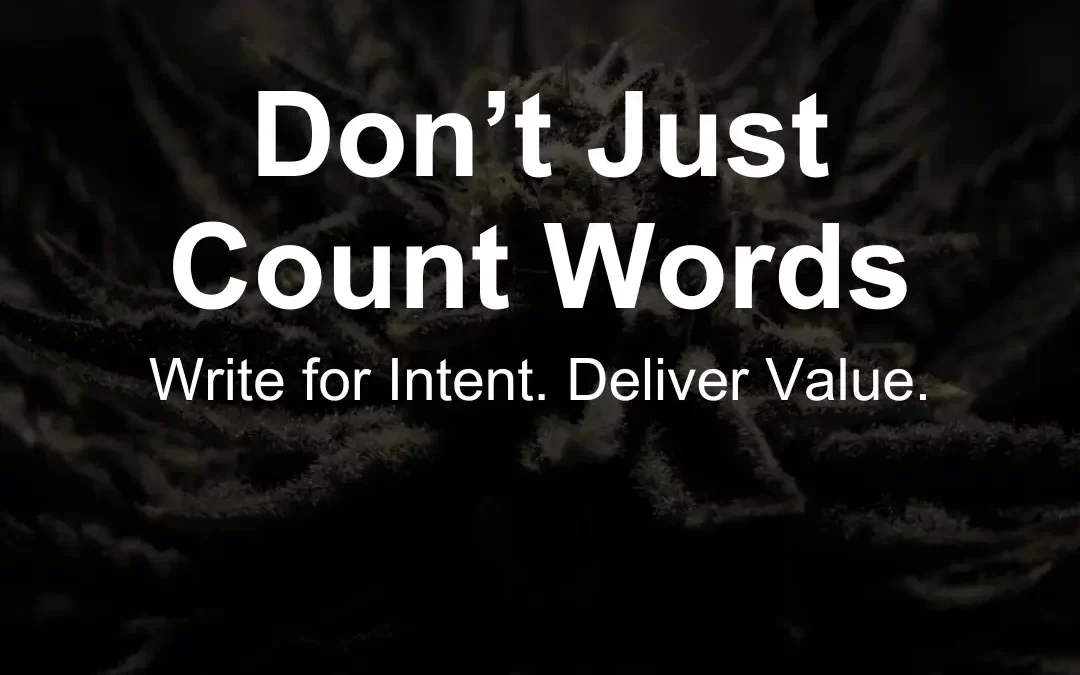Key Points
- Cannabis SEO, content quality is more critical than length, but longer content (1,500+ words) can help with rankings for in-depth topics.
- Balancing length and quality depends on search intent, with short-form content (300–800 words) working for quick queries like “dispensaries near me.”
- Prioritize user experience, compliance, and trust, especially in the regulated cannabis industry, where authoritative content builds credibility.
In the ever-evolving world of cannabis SEO, one question keeps popping up: Does longer content always rank better—or is quality more important?
For cannabis retailers looking to grow their organic traffic, the answer isn’t one-size-fits-all.
Google’s search algorithm has become smarter than ever in 2025.
Simply writing a 2,000-word blog post stuffed with keywords won’t guarantee you’ll show up on page one.
Instead, Google wants useful, people-first content—but that doesn’t mean length doesn’t matter at all.
In this article, we’ll break down the relationship between content length and quality, show you what really works for cannabis SEO, and give you a step-by-step checklist you can use to strike the right balance.
TL;DR: Longer content tends to perform better—but only when it’s high-quality and satisfies search intent. Quality is the priority. Length supports it.
Why This Matters In The Cannabis Industry
Cannabis businesses face stricter content policies, limited advertising channels, and high competition in local SEO.
That means your website content has to work extra hard to rank—and convert.
When consumers Google things like.
- “What’s the difference between indica and sativa?”
- “Best edibles for sleep”
- “How does CBD work?”
…they’re expecting detailed, trustworthy answers.
Google rewards sites that fulfill this expectation with higher rankings, especially when the content is backed by real-world experience (E-E-A-T) and is easy to consume.
What The Data Says: Content-Length Vs. Quality In 2025
Here’s what’s holding true in today’s SEO environment.
- Long-form content (1,500–2,500+ words) often ranks better for informational searches (like “how to use cannabis tinctures”).
- Shorter content (300–800 words) works well for local SEO, quick FAQs, product pages, or announcements.
- Google rewards topical depth, clear structure, original insights, and trustworthy information—not fluff.
- Content that matches search intent (the user’s goal) always wins over content that simply checks SEO boxes.
“Longer content ranks because it’s more likely to answer every question a searcher has—not because of its word count alone.”

Key SEO Trends For Content Length And Quality
Several trends shape content SEO in 2025.
- AI and User Intent: With AI algorithms like Google’s MUM, search engines better understand user intent, shifting focus from length to relevance. Content Length: What’s the Ideal Length of a Blog Post for SEO in 2025? notes that a 2,000-word fluff piece won’t outrank a concise, high-quality 800-word article that matches intent.
- Long-Form for Authority: Longer content (1,500+ words) dominates for informational queries, as seen in SEO Content Length: Longer Content Gains Higher Search Ranks, which cites studies showing long-form content is more engaging and shareable.
- Short-Form for Quick Queries: Short content (300–800 words) is effective for transactional or navigational searches, such as local queries, as noted in SEO Content Length 101: Why Longer Content Isn’t Always Better.
- User Experience: Factors like dwell time and bounce rate are influenced by content quality, not just length, as per Content length, depth and SEO: Everything you need to know in 2025.
- Cannabis-Specific Needs: The industry requires compliant, trustworthy content, often necessitating longer pieces to cover legal updates or medical benefits, while local SEO demands concise, optimized pages.
Common Cannabis SEO Myth: “Longer Is Always Better”
Many cannabis brands fall for this myth: Just write a 2,000-word blog post and you’ll rank. That’s not the case.
If your blog post is long but shallow, filled with generalizations or outdated info, it won’t help you rank—and worse, it might push visitors away.
Instead, think like this.
“The best-performing cannabis content answers the reader’s question completely, quickly, and clearly—whether that takes 500 words or 2,000.”
So… Should You Go Long or Keep It Short?
It depends on what your audience is searching for.
| Content Type | When to Use | Recommended Length |
|---|---|---|
| Product Pages | Local SEO, eCommerce | 300–600 words |
| FAQ Pages | Address common questions | 300–800 words |
| Dispensary Guides | How-to or beginner content | 1,200–2,000+ words |
| Health Topics | CBD/THC benefits, dosage, safety | 1,500–2,500 words |
| Strain Reviews | Brief with unique insights | 800–1,200 words |
| Law & Compliance Updates | News-style blogs | 600–1,000 words |
Pro Tip: Use Google’s “People Also Ask” box to expand short-form content with real, related questions to increase value without fluff.
Practical Tips For Balancing Length And Quality
To create cannabis content that ranks, follow these strategies.
- Understand Search Intent: Use tools like Google Search Console to identify what users are searching for and tailor length accordingly.
- Create Pillar Content: Develop long-form articles (1,500–3,000 words) on key topics like “The Ultimate Guide to Cannabis Strains” to establish authority.
- Optimize for Local Searches: For local queries, create concise pages (300–800 words) with location-specific keywords and maps.
- Enhance with Multimedia: Use images, videos, and infographics to boost engagement, especially for strain reviews or product pages.
- Stay Compliant: Ensure all content meets legal standards for cannabis advertising and information, avoiding unverified health claims.
- Monitor Performance: Track traffic and engagement with Google Analytics, adjusting your strategy based on data.
How Google Measures “Quality” In 2025 (Especially for Cannabis)
Google looks for content that exhibits E-E-A-T.
- Experience: First-hand knowledge (e.g., written by a budtender or grower)
- Expertise: Accurate and researched information
- Authoritativeness: Your site’s reputation in the cannabis space
- Trustworthiness: Honest, fact-checked, safe content
Cannabis is considered a Your Money or Your Life (YMYL) topic, so Google holds it to higher standards.
Claims about health benefits, legality, or usage must be backed up and responsibly written.
How To Balance Length And Quality In Your Cannabis Blog Content
Here’s a step-by-step checklist to guide you.
Step-By-Step Checklist For High-Performing Cannabis Content
- Start with Search Intent
- Ask: What is the reader trying to learn or solve with this query?
- Check what’s ranking for the keyword to understand expectations.
- Choose an Appropriate Format & Length
- Informational = go long.
- Local/store-related = stay brief and direct.
- Outline Before You Write
- Plan sections based on subtopics or user questions (great for H2s).
- Use tools like AnswerThePublic or AlsoAsked to fill gaps.
- Write for Humans First, SEO Second
- Use natural language.
- Include the main keyword + synonyms.
- Avoid repeating phrases just to meet a word count.
- Learn more: How To Write Cannabis Blog Posts That Rank In 2025
- Focus on Depth, Not Fluff
- Include examples, data, expert quotes, or firsthand experience.
- Answer related follow-up questions to enrich the content.
- Use Clear Structure
- Use headings (H2s, H3s), bullet points, and short paragraphs.
- Add internal links to product or location pages.
- Support Claims
- Cite reputable sources, studies, or government regulations.
- Include a disclaimer when writing about medical or legal topics.
- Add Multimedia
- Use images, infographics, videos, and charts where it adds value.
- Don’t forget alt text for accessibility and SEO.
- Edit Ruthlessly
- Remove filler words.
- Make every section useful or delete it.
- Publish & Monitor
- Track keyword rankings and engagement.
- Revisit posts quarterly to update facts and improve quality.
Real-World Example
Let’s say you want to write a blog post.
“How to Use Cannabis Edibles For Sleep”
Best Practice
1,800–2,200 words, covering.
- Dosage guidance
- Onset time vs smoking
- Best strains for sleep
- Legal disclaimers
- Personal anecdotes or customer insights
- Internal links to edible product pages
Learn more: Product-Led SEO For The Cannabis Industry: How To Rank, Engage, And Convert Customers
What Not To Do
A 3,000-word post repeating the same definitions or regurgitating what 10 other blogs already say.
Final Thoughts: Content That Helps Is Content That Ranks
Don’t write long for the sake of it.
Don’t sacrifice quality to pump out blogs fast.
Instead, aim for the sweet spot.
- Length that matches the complexity of the topic
- Quality that satisfies both Google and real humans
If you’re unsure how to find that balance, working with a cannabis SEO expert can save you time and frustration.
At Hemp Writer, we specialize in creating SEO-optimized blog content that ranks and converts—all while staying compliant.
Our cannabis SEO writer focuses on quality, well-structured content that drives real results.
Need Help Writing Content That Ranks?
Check out our content SEO service to get expert-crafted blog posts tailored for your cannabis brand.




